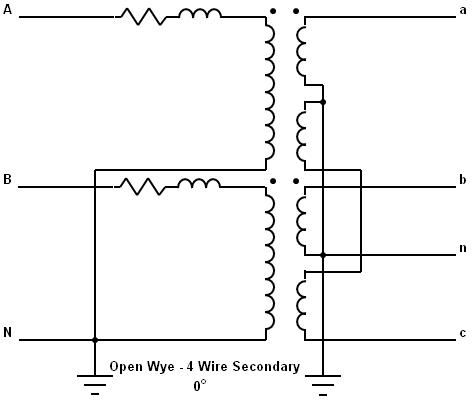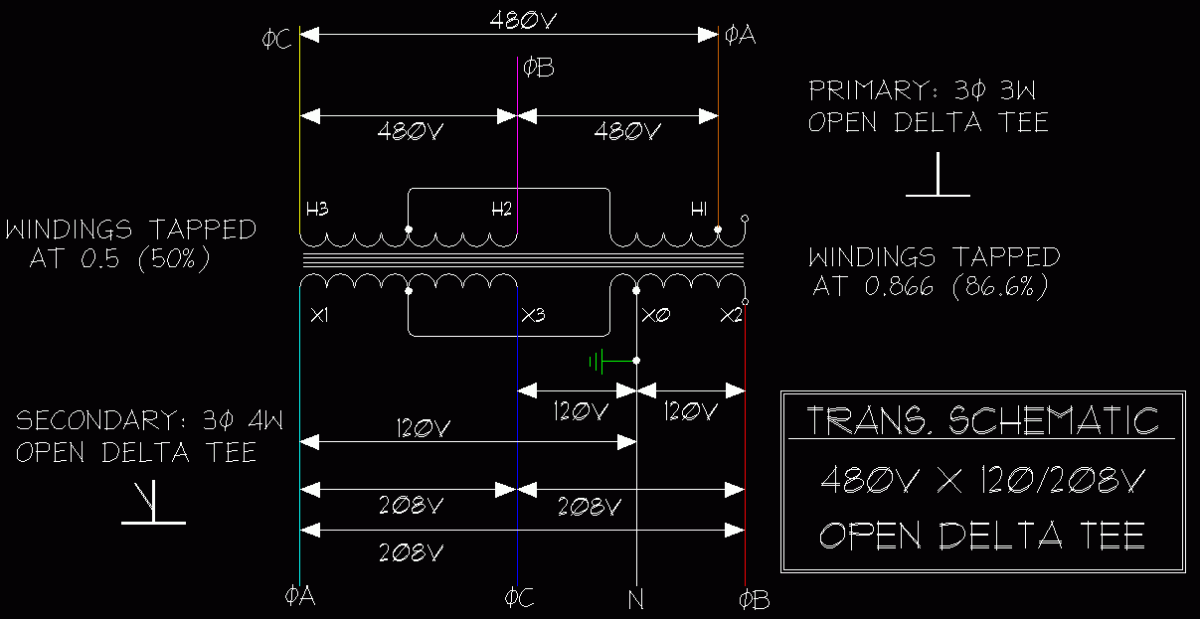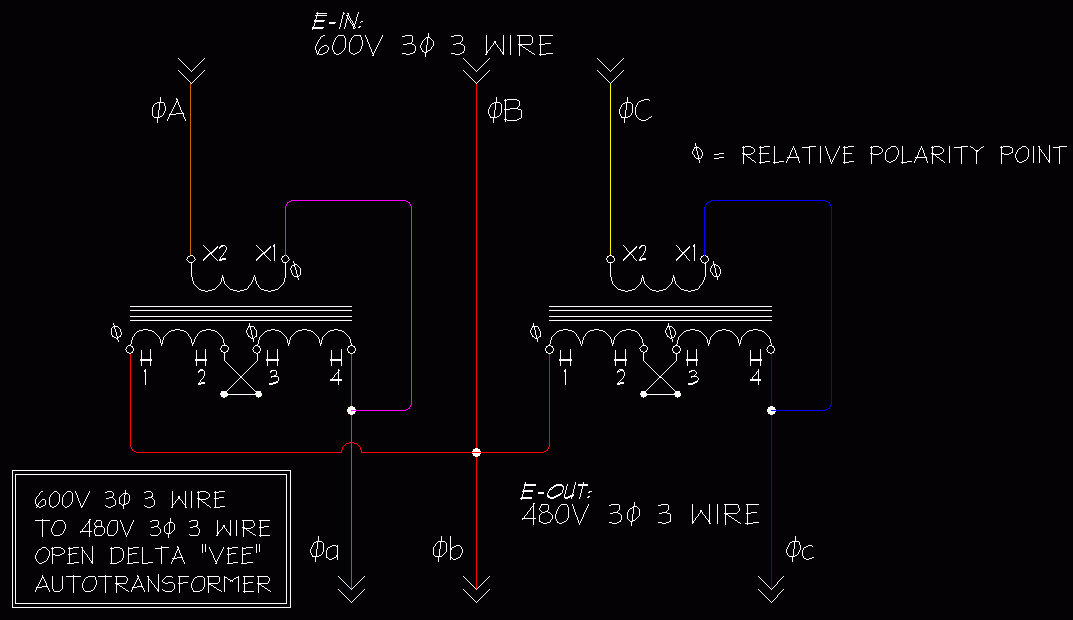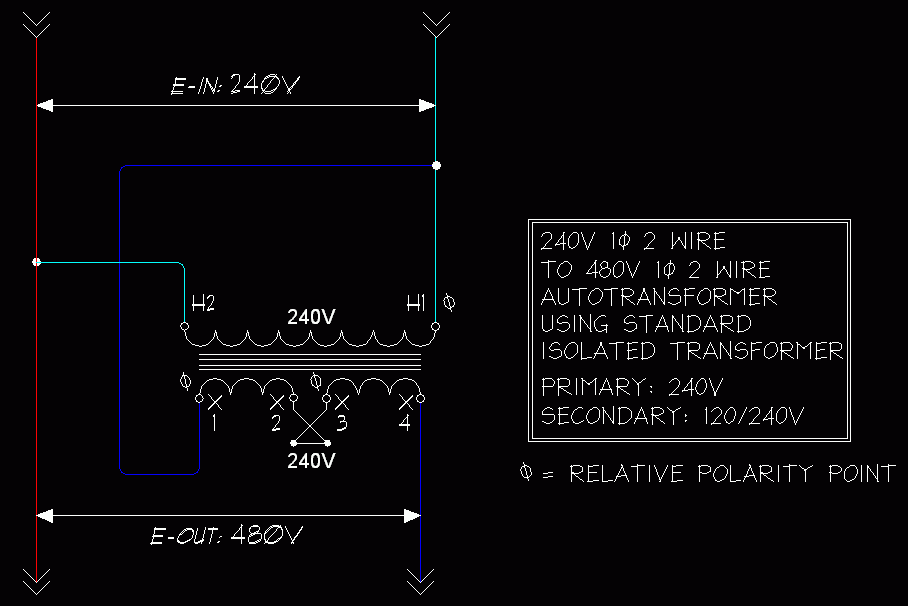robbietan
Senior Member
- Location
- Antipolo City
Well it would become one single phase with center tap, no?
open delta transformer?
Well it would become one single phase with center tap, no?
The three-phase transformer is slightly more efficient than three single-phase transformer, as there is less iron per kilowatt output, but the cost of upkeep and of spare units is greater. In sizes above 2000 kva and above 66,000 volts the three-phase transformer can be built somewhat more cheaply than three single-phase transformers totaling the same capacity,
You could roughly simulate a center tapped secondary with two separate single phase transformers with primaries connected in series or parallel so the secondary voltages were 180 deg out of phase.
Two separate coils connected together are not the same as a center tapped coil unless the magnetic flux coupling to the two coils is the same as that coupling to the single coil.Well there is the term I was looking for. I know that a center tap is really in the mid point of the winding but electrically it will simulate the same thing with two coils in series which essentially becomes one coil that has a tap midpoint. Physically it is not the same but electrically it is. This is why the transformer will run both single and three phase loads simultaneously.
and the answer is no.My question is doesn’t the transformer (after C coil failure) electrically become a single-phase center-tapped transformer? If so, then the voltage would need to change, right? Would the voltage then become 104/208?
Did you have a question?El' Bump'o!!!
Any responses to the last post (open wye scenario)
Scott
Okie-dokie!Any responses to the last post (open wye scenario)
This is exactly how the POCO delivers open Deltas, which originated as 3ph modifications to existing 120/240v 1ph services. Note that the 120/240v section of a 4-wire open Delta is identical to a 120/240v 1ph service.Bring out Phases "A" + "B", along with the Conductor tapped at the Star Point (in this case, the Grounded Conductor "N") from a 3 Phase 4 Wire Wye Secondary.
The "A-B-N" Circuit could be connected to the Primary side of an Open Wye / Open Delta Transformer setup, and derive a 3 Phase 3 Wire Delta, or 3 Phase 4 Wire Delta on the Secondary side.
These connections are nowhere near being parallel. At most, you could loosely say that the two secondaries of an open Delta are in series, with one conductor common to both.Example:
The "A-B-N" Circuit is 208/120V (208V L-L, 120V L-N).
Circuit feeds an Open Wye x Open Delta Transformer setup, which consists of (2) separate Isolated Transformers (may be split coil windings on pri. + sec., or just single windings).
Primary Windings of Transformer configured / rated for 120V.
Primaries of both Transformers connected in Parallel, with one end of each Primary Winding (H2 from Trans #1, H1 from Trans. #2) connected to Line "N" ("N" is comon to both Primary Windings).
Secondary Windings connected in Parallel - to form an Open Delta configuration.
BTW, Mivey:
How can a 4 Wire Wye Secondary (3 Transformers) derive from an Open Wye Primary (2 Transformers)

I wouldn't say all that. It is just a common connection we see a lot and is considered a standard connection. This was common as far back as at least the 50's and probably much longer than that.Sorry once again for posting a message, which clearly illustrates my lower intelligence / substandard cognition, and for producing "Mere matter of fact" discussion topics.
I will try harder to comply in the future.
Scott
No need for you or anyone else to apologize. You asked for comments, and got one. My post was in no way intended as a dressing down.Sorry guys, I thought this would be an interesting subject to discuss with other members - more specific, those members whom have not experienced non-standard Transformer configurations.
They do function somewhat similarly, but the best comparison is between the 120/240v 1ph transformer and the center-tapped transformer of an open or full Delta.Kind of covering the way a "common" Grounded Conductor, derived from the Star Point of a Wye Configuration, differs greatly in operation (function) from the center tapped Grounded Conductor of a Single Phase system.
It's rare for open Deltas to be supplied by all three phases, as it basically elimiates one of the open-Delta's benefits: requiring only two phases (and the system neutral, of course.)As to the differences in Open Wye and Open Delta Primary;
Open Delta Primary is lacking one Transformer (configuration is two single phase transformers), which may or may not utilize a Grounded Conductor at the Primary side (Phases "A", "B" and "C" will be fed to the Primary of the Open Delta Primary Transformer).
You're describing any basic Delta set-up there.If the Primary Circuit contains a Grounded Conductor, this would derived from a Corner Grounded Delta.
The L-L Primary Voltage would match the Primary Winding Voltage, so Primary Feeder connections may be "rotated" without possibility of letting smoke out of Primary Windings.
Absolutely.Open Wye Primary is also lacking one Transformer (comprised of two - single phase transformers), but is almost always fed with a Grounded Conductor + two Ungrounded Conductors.
No argument there. Let's not do that, though.The Open Wye Primary is fed with the Common Conductor, derived from the Star point connection of the 3 Coil Windings of a 3 Phase Wye; and two of the three coil leads from the opposite ends of the three coils (AKA "Phase Lines").
The Common Conductor derived from the Star Point is normally Grounded, and thus is a system Grounded Conductor.
The Open Wye Primary Windings will have a Voltage rating of 57.7% the L-L Voltage (E-LL ?1.732), so therefore the Primary Feeders may be connected in only a single scheme, not in a "rotated" fashion, as was capable with the Open Delta Primary described previously.
To remove smoke from the Primary Windings on this Open Wye Transformer configuration:
1: Place the Common Conductor on an "Outside" Transformer Primary lead,
2: Connect one of the remaining two Primary Feeder conductors to the common termination between the two separate Transformers,
3: Connect the remaining Feeder to the "Outside" lead of the second Transformer,
4: Connect Feeders to a Polyphase Power Supply with ample Apparent Power.
Smoke will begin to emit from the Transformer with the Primary Winding connected L-L (the "Second" Transformer).
Plus, as I suggested earlier, the presence of single-bushing transformers.OALN...
The Open Wye Primary setups used by Utility Companies (Primary Distribution Feeders), are easy to identify - as they have no fuse in the common Grounded Conductor's Primary Termination.
"Where's the beef?!"I shall attempt to post more "meaty" material in the future.
scott -...FWIW, the Primary may also be configured as Open Delta "VEE" or "TEE", with the Secondary configured as 120\208V 3? 4 Wire Open Delta TEE....
Nope. You are completely off track. Look at the diagram and more closely. When trying to analyze a transformer connection, it is helpful to actually assign some voltages and follow the connections.Mivey;
The Schematic in your latest reply is the Open Delta "TEE" configuration I had mentioned in the previous post.
Primary is Open Wye; Secondary is Open Delta TEE.
Schematic is somewhat crude, as it does not include tapped sections on the Secondary Windings.
FWIW, the Primary may also be configured as Open Delta "VEE" or "TEE", with the Secondary configured as 120\208V 3? 4 Wire Open Delta TEE.
Well, they can as it is a common utility connection. The benefit here is saving a pot. Also, open-delta to open-delta might not have a ground on the secondary center-tap.It's rare for open Deltas to be supplied by all three phases, as it basically elimiates one of the open-Delta's benefits: requiring only two phases (and the system neutral, of course.)
Besides, I don't recall ever seeing primary distribution without a grounded conductor along for the ride. I can't imagine the power company leaving transformer cans floating.
scott -
I don't think I've ever seen a "Secondary configured as 120\208V 3? 4 Wire Open Delta TEE". Could you post a sketch or a link, showing the connections and vector relationships?




I don't need the exercise, but if you think it is something that will help you, I'll be glad to do it. But, it would probably be more useful to you if you gave it a shot first.Mivey:
How about these Transformer Schematics... Want to toss some numbers to these?
